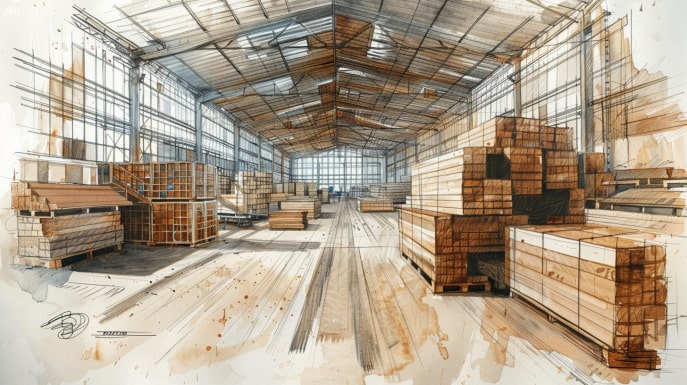






A 2-day immersion into the future of sustainable construction
In the world of construction, the green revolution is not just a buzzword; it’s a paradigm shift. Recycled construction materials are at the forefront of this shift, offering a pathway to sustainable, eco-friendly building practices without sacrificing quality or aesthetics. Let’s dive into the world of recycled materials, where every piece of reused steel or glass tells a story of innovation, sustainability, and hope for a greener planet.
Why Use Recycled Construction Materials?
The Green Trio: Environmental, Economic, and Ethical Wins
Environmental Benefits: Imagine a world where every building, bridge, and roadway contributes to a healthier planet. That’s the power of recycled construction materials. By repurposing what already exists, we slash the demand for virgin resources, reduce landfill waste, and cut down on energy consumption associated with manufacturing new materials. It’s like hitting an eco-friendly jackpot.
Economic Advantages: Think green, save green. Using recycled materials often costs less than their virgin counterparts. Plus, the growing demand for sustainable building solutions opens up new markets and opportunities for forward-thinking companies. It’s a win-win where saving the planet also saves pennies.
Enhancing Sustainability in Construction: By integrating recycled materials into construction projects, we’re not just building structures; we’re constructing a legacy of sustainability. It’s about leaving a world for future generations that’s not only habitable but thriving.
Types of Recycled Construction Materials
Embarking on a treasure hunt for materials that are ready for a second life in construction? Here’s your map.
The Treasure Trove of Recycled Materials
| Material | Description | Common Uses |
|---|---|---|
| Recycled Steel | Strong, durable, and infinitely recyclable. A superhero in the recycled materials world. | Beams, reinforcements, and frames. |
| Recycled Concrete | Crushed and reborn, it’s the Phoenix of the construction materials world. | Aggregate, road base, and new concrete. |
| Recycled Glass | Transforms from bottles to beauty, adding sparkle to tiles and countertops. | Tiles, countertops, and decorative elements. |
| Recycled Wood | Old wood finds new life, bringing warmth and character to any space. | Flooring, paneling, and furniture. |
| Innovative Materials | From plastic bottles to old jeans, these are the wildcard entries transforming waste into wonder. | Insulation, acoustical materials, and unique finishes. |
Diving Deeper into Innovation
Innovative materials are the wild cards of the recycled world. Think of plastic bottles turned into fiber for insulation or old jeans finding new life as soundproofing material. It’s a realm where creativity meets sustainability, and the results are both functional and fascinating.


Sourcing Recycled Construction Materials
The Quest for Quality
Finding suppliers for recycled construction materials can feel like searching for hidden treasure. Yet, the quest is well worth it. Here’s how to embark on this adventure:
- Start Local: Check out salvage yards, local recycling centers, and companies specializing in reclaimed materials. Not only does this support the local economy, but it also reduces transportation emissions.
- Certifications and Quality Standards: Look for suppliers that adhere to recognized certifications and standards. This ensures that the materials you’re using are not only eco-friendly but also meet the rigorous demands of construction projects.
The Supplier’s Pledge
When you find a supplier that shares your commitment to quality and sustainability, you’ve found a partner in the truest sense. These relationships are key to driving the recycled materials market forward, paving the way for a future where every construction project is a testament to sustainability.
This exploration into recycled construction materials is just the beginning. As we delve deeper into the nuances of sourcing, challenges, and implementation, remember that each step taken towards sustainability is a step towards a brighter, greener future. Stay tuned for the next chapters in this ultimate guide, where we’ll uncover more secrets to making sustainable construction a concrete reality.
Continuing our journey through the world of recycled construction materials, we delve deeper into the challenges that come with this green revolution and the innovative solutions that are paving the way for a more sustainable future. We also explore how these materials are integrated into construction projects, turning theoretical benefits into tangible realities.












A 2-day immersion into the future of sustainable construction
Challenges and Solutions for Recycled Construction Materials
Navigating the Roadblocks
Quality Concerns: One of the biggest hurdles in adopting recycled materials is the perception of inferior quality. The solution? Rigorous testing and quality control measures that prove recycled materials can meet, if not exceed, the performance standards of their virgin counterparts.
Availability Issues: Sometimes, finding the right type of recycled material in the necessary quantity can be challenging. The key is developing a robust network of suppliers and exploring alternative materials that can serve the same purpose.
Case Studies: Overcoming Challenges
Let’s look at real-world examples where challenges were not just met but turned into opportunities:
- Project Green School: Faced with a tight budget and a commitment to sustainability, a school in California opted for recycled steel and glass in its construction. The result? An eco-friendly building that came in under budget and serves as a model for sustainable development.
- Eco-Residential Complex: A developer in Sweden faced skepticism about the use of recycled wood in their new residential project. By partnering with a local recycling firm to ensure quality and hosting open days to educate the community, they not only overcame the stigma but also sold out the complex months before completion.
Implementation in Construction Projects
Building with the Future in Mind
Integrating recycled materials into construction projects requires a shift in mindset, from viewing materials as disposable to seeing them as valuable resources. Here’s how savvy builders are making this shift:
- Designing for Sustainability: Architects and engineers are increasingly designing buildings with recycled materials in mind, considering factors like durability, aesthetics, and environmental impact from the drawing board.
- Innovative Use Cases: From using crushed recycled glass in landscaping to repurposing old bricks in new walls, innovative use cases of recycled materials are expanding their appeal and application.
- Collaboration Across the Supply Chain: Successful integration of recycled materials into construction projects often involves close collaboration between architects, contractors, suppliers, and clients. This teamwork ensures that materials are not only used effectively but also contribute to the project’s overall sustainability goals.


Best Practices for Integrating Recycled Materials
To ensure the successful use of recycled materials in construction, consider the following best practices:
- Early Planning: Incorporate recycled materials into the project plan from the outset to avoid logistical headaches later on.
- Supplier Relationships: Build strong relationships with suppliers to ensure a steady supply of high-quality recycled materials.
- Education and Training: Educate construction teams on the benefits and proper handling of recycled materials to ensure they are used to their full potential.
- Innovation and Flexibility: Be open to innovative uses of recycled materials and flexible in design and execution to accommodate the unique characteristics of these materials.
As we continue to explore the role of recycled construction materials in modern building practices, it’s clear that the challenges are matched by the opportunities. The examples and strategies outlined here demonstrate that with creativity, collaboration, and commitment, the construction industry can lead the way in sustainability. Stay tuned for further insights into regulations, economic considerations, and more in the upcoming sections of this ultimate guide. Together, we’re building a greener, more sustainable future—one recycled material at a time.
As we forge ahead in our comprehensive exploration of recycled construction materials, we turn our focus to the regulatory landscape that governs their use and the economic considerations that make them an appealing choice for the construction industry. The journey toward sustainability is not just about making the right choices for the environment but also about understanding the framework within which these choices are made and the financial implications they carry.
Regulations and Standards for Recycled Construction Materials
Navigating the maze of regulations and standards can feel daunting, but it’s crucial for ensuring that recycled materials are used safely and effectively in construction projects.
The Regulatory Framework
| Country/Region | Regulatory Body | Key Standards |
|---|---|---|
| United States | EPA, ASTM | ASTM D5033 for recycled plastics, LEED certification for green buildings |
| European Union | European Commission | EN 206 for concrete, Eurocodes for construction products |
| Australia | Standards Australia | AS 5100 for bridge design, including the use of recycled steel |
Certification Processes
Obtaining certification for a project using recycled materials can enhance its credibility and marketability. Key certifications include:
- LEED (Leadership in Energy and Environmental Design): Recognizes best-in-class building strategies for sustainability.
- BREEAM (Building Research Establishment Environmental Assessment Method): Assesses the sustainability of buildings in various categories including materials.
- Green Star: A comprehensive environmental rating system for buildings that encourages the use of recycled and environmentally friendly materials.
Understanding these regulations and striving for certifications not only ensures compliance but also demonstrates a commitment to sustainability that can set a project apart in the marketplace.
Economic Considerations
The adoption of recycled materials in construction is not just a matter of environmental responsibility; it’s also an economically smart choice.
Cost-Benefit Analysis
| Aspect | Virgin Materials | Recycled Materials |
|---|---|---|
| Initial Cost | Higher due to extraction and processing | Lower due to reduced processing needs |
| Long-Term Savings | Lower durability and potential for higher maintenance costs | Higher durability and reduced maintenance costs |
| ROI | Variable depending on the material and project specifics | Often higher due to lower initial costs and environmental incentives |
Long-term Savings and ROI With Recycled Construction Materials
Investing in recycled materials can lead to significant long-term savings. These savings come not only from the reduced cost of the materials themselves but also from potential tax incentives for green building practices, lower utility costs due to better thermal performance of certain recycled materials, and enhanced property values.












A 2-day immersion into the future of sustainable construction
Case Studies of Recycled Construction Materials
Highlighting real-world examples where the use of recycled construction materials led to both economic and environmental success.
- The Recycled Office Building: A corporate office in London utilized recycled steel and glass extensively, resulting in a 20% reduction in construction costs and a LEED Gold certification that enhanced its rental and resale value.
- Eco-Friendly Residential Development: A residential project in Vancouver featured recycled wood and insulation materials, leading to lower heating costs for residents and a prestigious environmental award that boosted its marketability.
These case studies demonstrate the tangible benefits of incorporating recycled materials into construction projects, showcasing that sustainability and economic viability can go hand in hand.
The narrative of recycled construction materials is one of innovation, resilience, and sustainability. Through understanding the regulatory environment, recognizing the economic benefits, and learning from real-world applications, the construction industry can embrace recycled materials not just as an alternative, but as a preferred choice for building a greener future. The journey towards sustainable construction is ongoing, and as we continue to explore the myriad facets of recycled materials, it’s clear that their potential is boundless. Stay tuned for further insights and explorations in the subsequent sections of this guide, where we will delve deeper into emerging trends, technologies, and the future horizon of recycled construction materials.
As we continue to build our knowledge on recycled construction materials, it’s crucial to understand the regulatory landscape and economic implications that accompany their use. Additionally, we’ll touch on some inspiring case studies that highlight the successful application of these materials in real-world projects.


Regulations and Standards of Recycled Construction Materials
Navigating the maze of regulations and standards is essential for anyone looking to incorporate recycled materials into their construction projects. Here’s a simplified guide to help you stay compliant and ensure your project not only meets but exceeds expectations.
Key Regulations and Certifications
- LEED Certification: The Leadership in Energy and Environmental Design (LEED) system is a globally recognized standard for measuring building sustainability. Using recycled materials can significantly contribute to achieving LEED certification points.
- Building Codes and Local Regulations: Always check local building codes, as they may have specific requirements or limitations regarding the use of recycled materials.
Ensuring Compliance
- Documentation: Keep detailed records of all recycled materials used, including their sources and any relevant testing or certification documents.
- Quality Assurance: Implement a quality assurance program to ensure that all recycled materials meet the necessary standards and are suitable for their intended use.
- Professional Guidance: When in doubt, consult with professionals who specialize in sustainable construction and regulatory compliance.
Economic Considerations For Recycled Construction Materials
While the environmental benefits of using recycled materials are clear, it’s also important to consider the economic aspect. Here’s a breakdown of how these materials can impact your project’s bottom line.
Cost-Benefit Analysis
- Initial Cost Savings: Recycled materials often come at a lower cost compared to new materials, offering immediate savings.
- Long-Term Savings: Buildings constructed with sustainable materials can lead to lower energy and maintenance costs over time.
- Market Value: Projects that prioritize sustainability can see an increase in market value, appealing to a growing demographic of eco-conscious buyers.
The Financial Impact Table
| Factor | Description | Potential Impact |
|---|---|---|
| Material Costs | Recycled materials can be cheaper than new materials. | Reduce initial construction costs. |
| Energy Efficiency | Buildings made with certain recycled materials can be more energy-efficient. | Lower ongoing operational costs. |
| Maintenance | Some recycled materials may require less maintenance. | Decrease long-term maintenance costs. |
| Property Value | Sustainability can increase a property’s appeal and value. | Increase in resale or rental value. |












A 2-day immersion into the future of sustainable construction
Case Studies: Recycled Construction Materials in Action
To inspire and illustrate the real-world potential of recycled construction materials, let’s look at a few standout projects:
The Eco-Friendly Office Complex
Location: London, UK
Materials Used: Recycled steel, glass, and wood
Outcome: The complex achieved a Platinum LEED certification and boasts reduced energy costs by 40% compared to traditional buildings.
The Sustainable Housing Development
Location: Vancouver, Canada
Materials Used: Recycled concrete for foundations, reclaimed wood for framing
Outcome: This development not only sold out quickly due to its sustainability credentials but also uses 30% less water and energy than conventional homes.
As we move towards wrapping up our ultimate guide on recycled construction materials, it’s evident that the journey towards sustainability in construction is both challenging and rewarding. Through understanding regulations, considering economic impacts, and drawing inspiration from successful case studies, we pave the way for a future where every construction project is a testament to innovation, sustainability, and responsible resource management. Stay tuned for the concluding sections, where we’ll wrap up our comprehensive exploration of recycled construction materials, offering final thoughts and resources for further learning.
As we approach the conclusion of our deep dive into recycled construction materials, let’s explore the future prospects of these materials in the construction industry and how they align with global sustainability goals. We’ll also provide a handy FAQ section to address common queries, and wrap up with a glossary of key terms and resources for further exploration.


Future of Recycled Materials in Construction
Emerging Trends and Technologies for Recycled Construction Materials
The future looks bright for recycled materials, with innovations and technologies making it easier and more efficient to recycle and reuse materials than ever before. Here are some emerging trends to watch:
- Advanced Recycling Processes: New technologies are making it possible to recycle materials more thoroughly, extracting maximum value from waste.
- Biodegradable Materials: Research into biodegradable construction materials is expanding, offering the potential to reduce waste even further.
- Smart Materials: Materials that can adapt to environmental conditions or heal themselves are on the horizon, promising to revolutionize construction.
The Role of Innovation With Recycled Construction Materials
Innovation plays a crucial role in expanding the use of recycled materials in construction. From developing new materials to finding novel ways to use existing ones, creativity and technology are key drivers of sustainability in the industry.
FAQs: Navigating Common Questions About Recycled Construction Materials
To help clarify any lingering doubts, here’s a quick FAQ addressing some of the most common questions about recycled materials:
- Are recycled materials as durable as new ones? Yes, when processed and tested properly, recycled materials can match or even surpass the durability of new materials.
- Can using recycled materials reduce construction costs? Absolutely. Recycled materials often come at a lower cost, and their use can contribute to savings on waste disposal and even earn sustainability certifications that increase property value.
- How can I find reliable suppliers of recycled materials? Start by checking local directories and sustainability networks. Don’t hesitate to ask for certifications and quality assurance documentation.
Recycled Construction Materials: Glossary of Key Terms
To ensure clarity and understanding, here’s a glossary of key terms related to recycled construction materials:
- Sustainability: The practice of meeting our own needs without compromising the ability of future generations to meet theirs.
- LEED Certification: A globally recognized symbol of sustainability achievement and leadership in the construction industry.
- Circular Economy: An economic system aimed at eliminating waste and the continual use of resources through recycling and reuse.
Resources and Further Reading About Recycled Construction Materials
For those eager to explore more about recycled construction materials and sustainable construction practices, here are some resources to get you started:
- BuildingGreen: A leading resource for information on sustainable building practices and materials.
- The Construction Materials Recycling Association (CMRA): Offers extensive information on recycling materials in the construction industry.
- Green Building Councils: National councils often provide guidelines, case studies, and resources for sustainable construction in specific regions.
If you want to discover our Portuguese language courses and consultancies for architects and designers, click here.












A 2-day immersion into the future of sustainable construction

